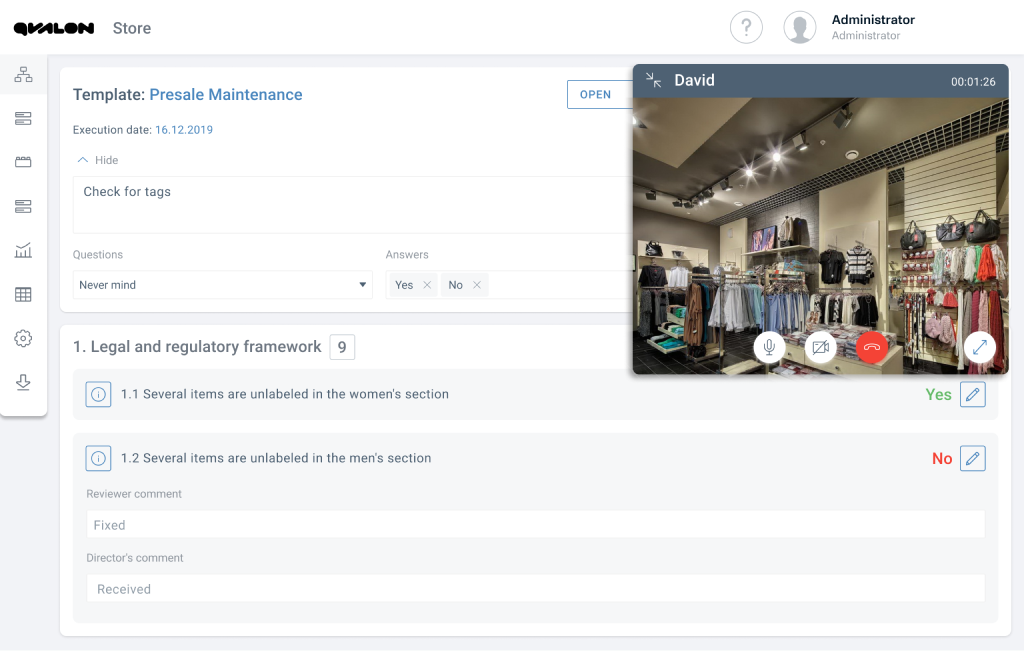Qvalon Blog article content
In this article, we’ll take a look at 2 of the most important areas in any Fashion Retail business — the warehouse, and the Sales Floor. While these 2 units are “opposites” — the warehouse is “behind the scenes” and the sales floor is customer-facing-the processes of the one directly affect the other. Let’s take a closer look:

Warehouse Operating Processes
Using the modules of the QVALON system, checklists, photo reports, and polls can be checked for:
1. The Warehouse Planogram
A warehouse is not just a room for storing goods, but a functionally organized space to facilitate the movement of goods between a warehouse and a sales unit. The quality of the execution of operational processes in the sales unit will depend on the quality of the organization of the warehouse space-its ergonomics. The principle of organizing the warehouse space is found in the “Warehouse Planogram”.
The steps and processes that produced the goods in the warehouse are hidden from the buyer’s eyes, but this does not mean that these operations should have lower standards than those set for the transactions made on the sales floor.
2. Acceptance of goods/re-inventorying of goods/posting of goods into the accounting system
For the reception, conversion, and posting of goods it‘s usually necessary to apply formulas that save time and errors, avoid shortages and surpluses, and allow time to fix and align the re-sorting of inventory balances.
3. Defects: cancellation of the defects/storage of defects
Defects can be found not only during the acceptance of goods-sellers often find defective goods on the sales floor, and customers don’t want defective goods for obvious reasons. All of these incidents must be documented, and certain adjustments need to be made to the defective goods according to the standards companies have put in place.
4. “Conservation” of goods
Often in fashion companies, there is a need for the seasonal storage of goods in a store’s warehouse without transporting it to the company’s main warehouse — the process of “conservation”. The organization of the “conservation” process requires personnel to strictly follow certain formulas to minimize errors in the accounting of goods.
5. Presale Maintenance/QC Items: steaming goods/price tags /anti-theft sensors
The execution and the quality of execution of this set of measures are crucial since it creates the image of the product in the eyes of the customer (the product is ironed, attractive, and the price is displayed). Clean and professional presentation of products increases the chances of purchase and helps the seller prevent potential material losses.
Salesfloor operating processes
As noted earlier, the operational processes of the sales area are inextricably linked to the operational processes of the warehouse, and poor quality/execution of warehouse operations in one way or another affects the quality of operations in the sales area.
Now that we’ve looked Given all of this information, what can we control with QVALON on the sales floor:
1. Sorting at the sales area from the warehouse
Choice in product display is crucial-customer’s want what they want when they want it, and sellers are obligated to provide it. To provide the customer with choice, the seller has to maintain a full range of available products, in all available colours and sizes, in the sales area. This means that staff need to constantly be sorting goods, and the process of sorting goods is not a one-time process-it occurs cyclically after customers buy out size ranges and models. Employees need to control this process, and quickly refresh the assortment of products in the sales area. This process needs to be organized so that any employee regardless of his/her experience in the industry or at the company, can quickly find the product they need and display it in the sales area or present it directly to the customer.
2. Goods re-evaluation
Revaluation of goods is an equally important process that must be legally controlled by each seller since the price on the product label always has to correspond to the price of the goods in the accounting system. Customer loyalty to the company depends on consistent re-evaluation because even one case of discrepancy between the price indicated on the product and the price charged by the cashier at checkout can leave a negative impression on the customer and damage trust between the customer and the brand in the long term. Beyond that, inaccurate pricing can lead to fines and penalties from government agencies.
3. Merchandising
Merchandising is a complex, voluminous operational process that includes several sub-processes:
- the process of placing groups of goods on the sales floor — zoning;
- the process of presenting goods: display/signage of goods on various types of trade equipment — planogram;
- the process of registering Promo goods with materials.
In the fashion industry, the implementation and maintenance of merchandising standards at a high level is not easy and is accompanied by additional layers of complexity — a constant change of goods and displays related to seasonality, the introduction of new collections, sales seasons, promo activities, and the sales of hit models.
Beyond that, store sales also dictate which products/displays can and should be comfortably presented to the buyer.
The most effective module in the QVALON system for checking merchandising standards is the Photo Reports module, which has been successfully used by merchandising specialists from various fashion companies. The tool contains a whole set of functional options to make standardized control processes transparent to both Merchandisers, as well as the Director of Sales and up.
4. Buyer services: consulting/ services/ speech scripts/ standards of staff appearance
It’s no secret that regardless of the company’s business model, pricing policy, store format, or product characteristics, high-quality customer service is critical to success in the fashion industry, especially at the store level. If store personnel don’t provide customers with the highest level of attention, courtesy, and care, the store will lose sales. The challenge is that all customers are different, but sellers need to provide the same quality of service to every customer. To prevent negative interactions between sellers and customers and increase the likelihood of sales, companies often develop formulas for employee actions-speech scripts, etc. Unfortunately, the presence of scripts and formulas does not yet guarantee that the staff performs them correctly. With the help of different modules of the QVALON system such as checklists, photo reports, and video analytics, managers can get real-time information about how well service standards are upheld both at the store and across the entire store network. If your company has also implemented standards for the appearance of personnel, then using the above modules you can also track the adherence to those standards and protocols.

5. Atmosphere and cleanliness of sales area: the style and volume of the music content, video content, advertising, and information content/lighting/temperature/smells/order
As we mentioned earlier, an important component of fashion shopping is emotion-and the emotion that a buyer experiences when visiting your store depends on you, and your store’s preparedness. Retailers themselves shape the emotional experience of the customer by creating a clean, comfortable, engaging atmosphere at the point of sale.
Aligning processes and standards across the warehouse, and the Sales Floor addresses two of the main areas that are most important to the success of any Fashion Retail company. If you’re front and back of the house are in order, and managed well, you can not only save time and effort but also prevent lost sales. Join us for our next article, where we dive deeper and look at the fitting room, the cashier, and the display window.



